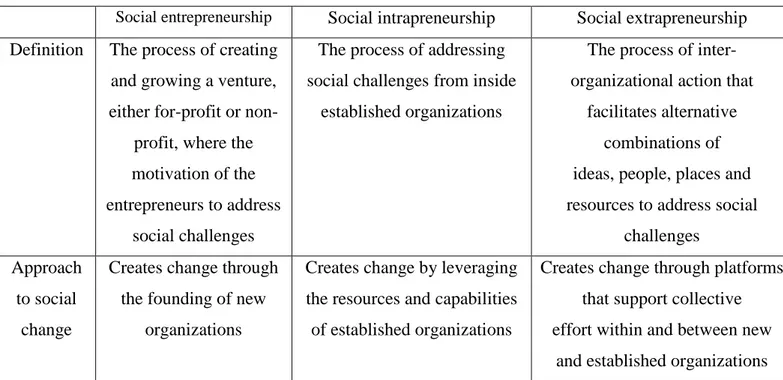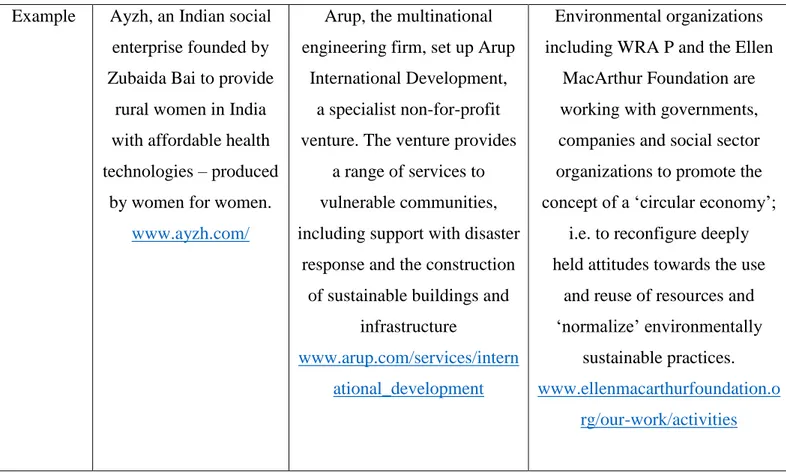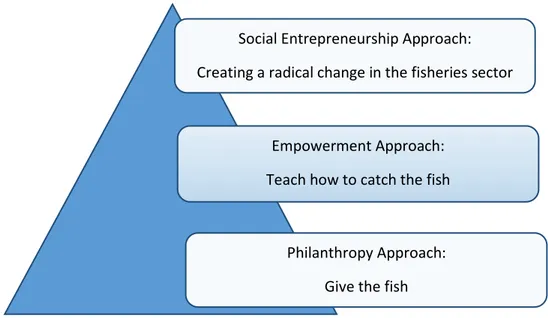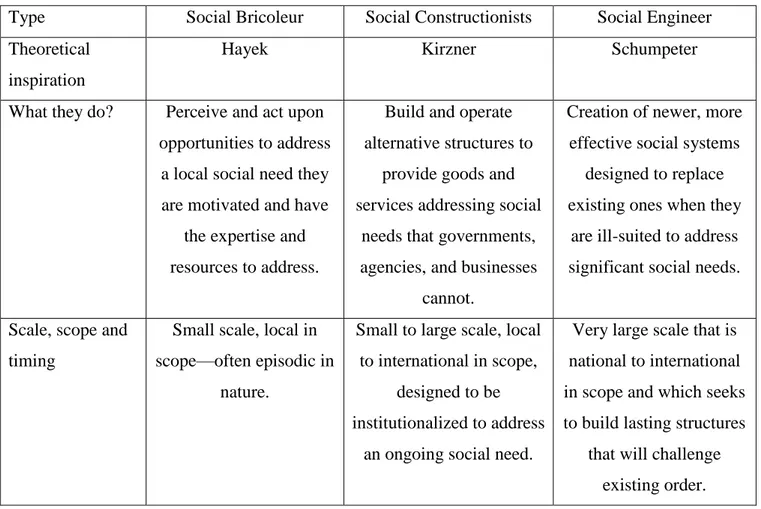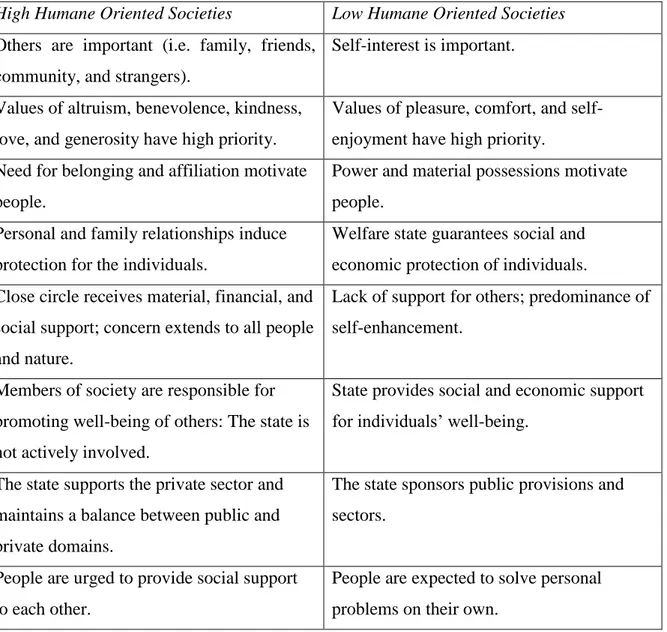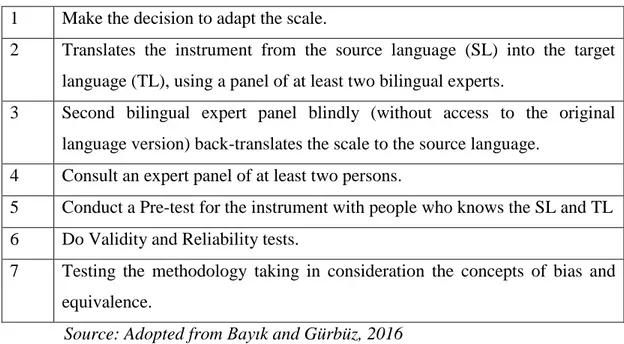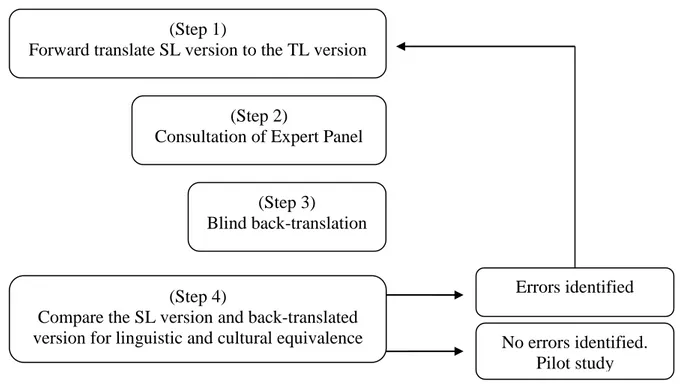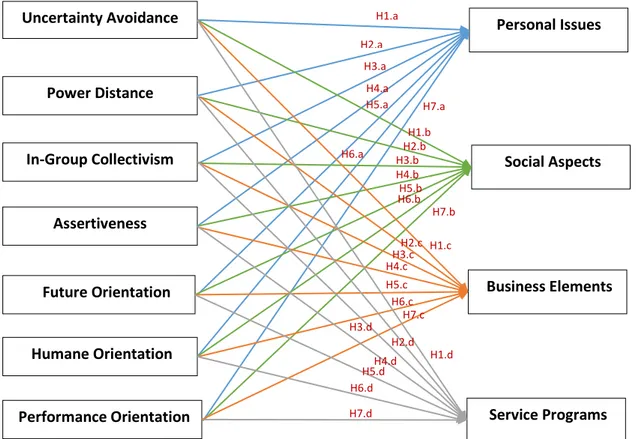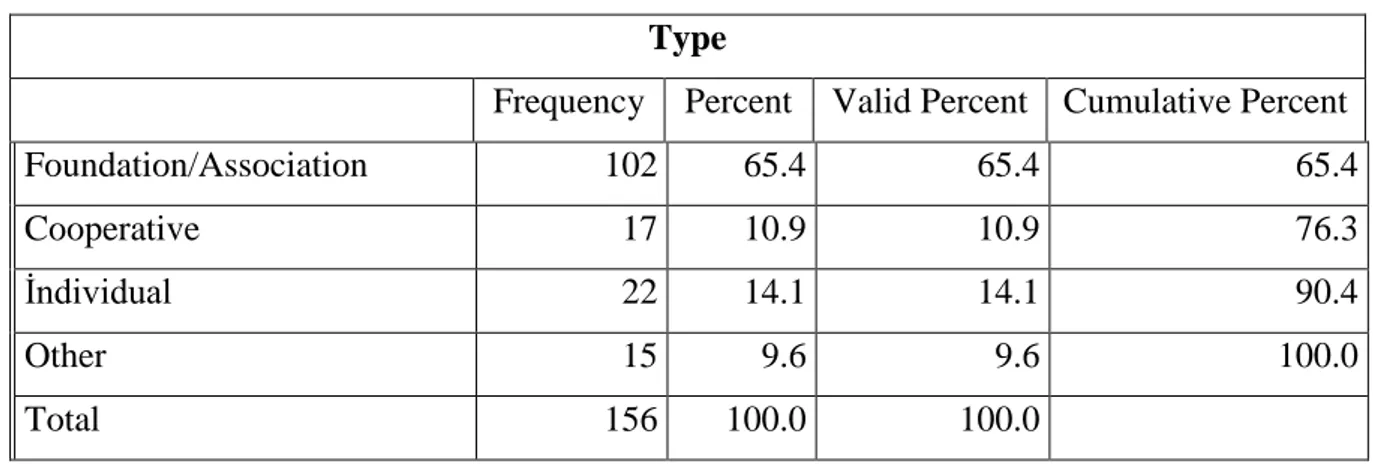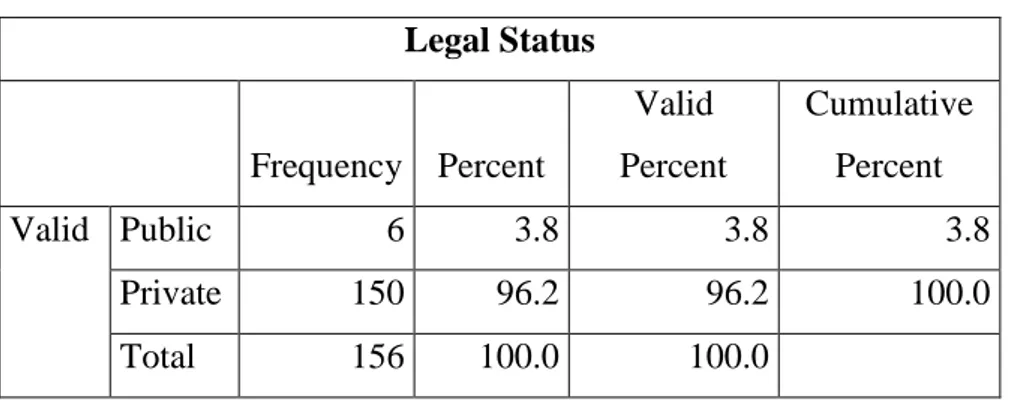UNDERSTANDING THE EFFECT OF CULTURE
ON SOCIAL ENTREPRENEURSHIP IN TURKEY
NIHAD ABUNASSER
ANKARA YILDIRIM BEYAZIT UNIVERSITY
UNDERSTANDING THE EFFECT OF CULTURE
ON SOCIAL ENTREPRENEURSHIP IN TURKEY
A THESIS SUBMITTED TO THE INSTITUTE OF SOCIAL SCIENCES
OF
ANKARA YILDIRIM BEYAZIT UNIVERSITY
BY
NIHAD ABUNASSER
IN PARTIAL FULFILMENT OF THE REQUIREMENTS FOR
THE DEGREE OF DOCTOR OF PHILOSOPHY IN
THE DEPARTMENT OF MANAGEMENT AND ORGANIZATION
Approval of the Institute of Social Sciences
_________________________
(Title and Name) Manager of Institute
I certify that this thesis satisfies all the requirements as a thesis for the degree of Doctor of Philosophy.
_________________________
(Title and Name) Head of Department
This is to certify that we have read this thesis and that in our opinion it is fully adequate, in scope and quality, as a thesis for the degree of Master of Science/Arts/Doctor of Philosophy.
_________________________ _________________________
(Title and Name) (Title and Name)
Co-Supervisor Supervisor
Examining Committee Members (first name belongs to the chairperson of the jury and the second name belongs to supervisor)
Prof. Dr. Nilay Alüftekin Sakarya (AYBÜ University, Management) _______________
Prof. Dr. Kerim Özcan (AYBÜ University, Management) _______________
Prof. Dr. Belgin Aydıntan (AHBV University, Management) ________________ Assoc. Prof. Dr. İrge Şener (ÇANKAYA University, Management) ____________ Assoc. Prof. Dr. Özge Gökbulut Özdemir (AYBÜ University, Management) _____________
iii
I hereby declare that all information in this thesis has been obtained and presented in accordance with academic rules and ethical conduct. I also declare that, as required by these rules and conduct, I have fully cited and referenced all material and results that are not original to this work; otherwise I accept all legal responsibility.
Name, Last name :
iv ABSTRACT
UNDERSTANDING THE EFFECT OF CULTRUE ON SOCIAL ENTREPRENEURSHIP IN TURKEY
Abunasser, Nihad
Ph.D., Department of Mangement and Organization
Supervisor : Prof. Dr. Nilay Alüftekin Sakarya
June 2019
Governments around the world extend their efforts to find solutions for social issues like poverty, and environmental challenges by setting policies and allocating budgets. But these efforts alone are not sufficient for sustainable development. The world needs new frameworks that address social challenges and justice, unemployment issues and climate change. In the last the decades, social entrepreneurships achieved success in solving such problems on different levels across nations. Social enterprises are business intended essentially for social benefits.
In this study, culture as a source of variation across people will be investigated in the Turkish context to explore the effect of social entrepreneurs’ cultural dimensions on social enterprises’ performance. For this aim a questionnaire consisting of cultural dimensions’ measurements and social enterprises performance scales used to collect data from 156 social entrepreneurs in Ankara. Results showed that cultural dimensions of uncertainty avoidance, in-group collectivism and assertiveness have a significant effect on how those social entrepreneurs perceive the performance of their social enterprises.
v ÖZET
KÜLTÜR, SOSYAL GİRİŞİMCİLİK ÜZERİNDEKİ ETKİSİNİ ANLAMAYA ÇALIŞAN BİR ARAŞTIRMA
Abunasser, Nihad
Doktora, Yönetim ve Organizasyon Bölümü
Tez Yöneticisi : Prof. Dr. Nilay Alüftekin Sakarya
Haziran 2019
Dünyanın dört bir yanında, hükümetler, politika belirleyerek ve bütçe ayırarak yoksulluk ve çevresel zorluklar gibi sosyal sorunlara çözüm bulma çabalarını giderek artırmaktadır. Ancak bu çabalar tek başına sürdürülebilir kalkınma için yeterli değildir. Dünyada sosyal zorlukları azaltacak, adaleti yaygınlaştıracak, işsizlik sorunlarını ve iklim değişikliğini ele alacak yeni çerçevelere ihtiyaç duyulmaktadır. Son yıllarda, sosyal girişimcilik yaklaşımı, bu tür problemleri ele alarak ülkeler düzeyinde farklı seviyelerde çözüm yaratılması hususunda ön plana çıkmaktadır. Bu da sosyal girişimler yani sosyal faydayı güden girişimler tarafından sağlanmaktadır.
Bu çalışmada, bireyler arasında farklılık gösteren kültür boyutlarının Türkiye bağlamı dikkate alınarak, sosyal girişimcilerin kültürel boyutlarının, sahip oldukları ya da yönettikleri sosyal girişimlerin performansına ait algıya olan etkilerinin araştırılması amaçlanmıştır. Bu amaçla, Ankara'daki 156 sosyal girişimciden veri toplamak için kültürel boyutların ve sosyal girişimlerin performans ölçeklerinden oluşan bir anket kullanılmıştır. Sonuçlar, kültürel boyutlardan olan belirsizlikten kaçınma, grup içi kolektivizm ve kararlılık ile, bu sosyal girişimcilerin sosyal girişimlerinin performansını nasıl algıladıklarını önemli ölçüde etkilediğini göstermiştir.
vi
vii
AKNOWLEDGMENTS
The author wishes to express her deepest gratitude to her supervisor Prof. Dr. Nilay Alüftekin Sakarya for her guidance, advice, criticism, encouragements and insight throughout the research.
The author would also like to thank Assoc. Prof. Irge Şener for her continues support, suggestions and comments.
The author would also like to thank Assoc. Prof. Özge Gökbulut Özdemir for her support, suggestions and comments.
viii TABLE OF CONTENTS PLAGIARISM ………. iii ABSTRACT ……… iv ÖZET ………. v DEDICATION ………. vi ACKNOWLEDGEMENTS………. vii
TABLE OF CONTENTS……… viii
LIST OF TABLES………... xi
LIST OF FIGURES………. xiv
LIST OF ABBREVIATIONS ……….. xv
CHAPTER 1. OVERVIEW OF THE STUDY………. 1
1.1 Introduction ………... 1
1.2 Problem Statement ………... 6
1.3 Aim of Research ……….. 7
1.4 Research Question ………8
2. LITERATRUE REVIEW……….. 9
2.1 Origins of Social Entrepreneurship field ………. 9
2.2 Definitions of Social Entrepreneurship and Social Entrepreneur ………. 10
2.3 Culture ………... 18
2.4 Culture at the Individual Level ……….. 20
2.5 Identified Scales and Dimensions for Culture ………... 21
ix
2.7 Culture and Social Entrepreneurship ……… 25
2.7.1 Uncertainty Avoidance ………... 27 2.7.2 Power Distance ………...… 29 2.7.3 In-Group Collectivism ……… 30 2.7.4 Assertiveness ……….. 31 2.7.5 Future Orientation ……….. 33 2.7.6 Humane Orientation ………... 34 2.7.7 Performance Orientation ……….... 36 2.9 Methodology ………. 38
3. APTATION OF CULTRUE ORIENTATION AND SOCIAL ENTREPRENERUSHIP PERFORMANCE SCALES TO THE TURKISH LANGUAGE ……….... 39
3.1 Brislin’s Model for Back-Translation ………..…. 40
3.2 Why scholars Prefer Instrument Adaptation ………. 41
3.3 Challenges that researchers may face in Scale Adaptation Process…………... 42
3.4 Scale Adaptation Procedure for This Study ……….. 42
4. RESEARCH DESIGN AND METHODOLOGY……….. 46
4.1 Research Methodology ………. 46
4.2 Variables ………..………. 49
4.3 Population and Sample ..………... 50
4.4 Data Collection……….. 51
4.5 Data Analysis………. 53
4.5.1 Descriptive Statistics ………..………. 53
4.5.2 Data Analysis Results for Cultural Orientations Scale ……… 56
4.5.3 Data Analysis Results for Social Enterprise Performance Scale …………. 61
x
4.5.4.1 Model 1 ………...65
4.5.4.2 Model 2 ……….. 69
4.5.4.3 Model 3 ……….. 73
4.5.4.4 Model 4 ……….. 75
5. DISCUSSION AND CONCLUSION ……… 79
5.1 Findings……….. 83
5.2 Limitations of this Research ……….. 85
5.3 Implications for Future Research ……….. 85
REFERENCES……… 88
APPENDICES A. SCENARİO-BASED SCALES MEASURING CULTURAL ORIENTATIONS OF BUSINESS OWNERS ……….. 96
B. SOCIAL ENTERPRISE PERFORMANCE SCALE ………105
C. CURRICULUM VITAE ………109
xi
LIST OF TABLES TABLES
Table 1.1 The difference between Commercial and Social entrepreneurship………...2
Table2.1 A typology of social innovation ……….. 10
Table 2.2 Definitions of social entrepreneurship ………... 12
Table 2.3 Definitions of social entrepreneurs ……….... 14
Table 2.4 A typology of social entrepreneurship ………... 15
Table 2.5 Definitions of Cultural Constructs ………. 23
Table 2.6 Social Enterprise Performance Dimensions ………... 24
Table 2.7 Tendencies of Higher versus Lower Societies on Uncertainty Avoidance ……… 27
Table 2.8 Higher Humane Orientation societies versus Lower Humane Orientation societies ………. 35
Table 3.1 Basic steps for acceptable scale adaptation work ………... 40
Table 4.1 Types of Social Enterprises that took place in the study ……… 54
Table 4.2 Legal Status of the Social Enterprises ……… 55
Table 4.3 Number of Employees in Social Enterprises ……….. 55
Table 4.4 Education levels of participating social enterprise owners ……… 56
Table 4.5 Reliability statistics of Cultural Orientations Scale ………... 57
Table 4.6 KMO and Bartlett’s Test for Cultural Dimensions Data ……… 58
Table 4.7 Values of Total Variance Explained ……….. 58
Table 4.8 The result of Factor Analysis ………... 59
Table 4.9 Reliability Statistics for Social Enterprise Performance Dimensions ……… 61
Table 4.10 KMO and Bartlett’s Test for Social Enterprise Data ………... 61
Table 4.11 Values of Total Variance Explained………. 62
xii
Table 4.13 Correlated variables in Model-1 ……….. 56
Table 4.14 Analysis result of the relationship between Cultrue and PI ………. 56
Table 4.15 Analysis of Variance ……… 66
Table 4.16 Correlations’ Coefficients ……… 66
Table 4.17 testing the relationship between Cultrue and PI after removing PD and PO …... 67
Table 4.18 Analysis of Variance ……… 68
Table 4.19 Correlations’ Coefficients ……… 68
Table 4.20 Correlated Variables in Model-2 ……….. 69
Table 4.21 Analysis result of the relationship between Cultrue and SA ……… 69
Table 4.22 Analysis of Variance ……… 70
Table 4.23 Correlations’ Coefficients ……… 70
Table 4.24 remain variables in Model-2 ……… 71
Table 4.25 Model Summary ………... 71
Table 4.26 Analysis of Variance………. 72
Table 4.27 Correlations Coefficients ……….. 72
Table 4.28 Correlated Variables in Model-3 ……….. 73
Table 4.29 Analysis result of the relationship between Cultrue and BE ……… 73
Table 4.30 Analysis of Variance ……… 74
Table 4.31 Correlation Coefficients ………... 74
Table 4.32 Correlated Variables in Model-3 ……….. 75
Table 4.33 Analysis result of the relationship between Cultrue and SP………. 75
Table 4.34 Analysis of Variance ……… 76
Table 4.35 Correlation Coefficients ………... 76
xiii
Table 4.37 Analysis of Variance ……… 77
xiv
LIST OF FIGURES FIGURES
Figure 2.1 Social Entrepreneurship Guide for Social Transformation ………... 14
Figure 2.2 Clusters of Cultural Regions……….. 26
Figure 3.1 Brislin’s Back-Translation process ………... 41
Figure 4.1 Model of the Study ………... 49
Figure 4.2 The online Questionnaire ……….. 52
Figure 4.3 Modified Model of the Study ……… 64
xv LIST OF ABBREVIATIONS UK United Kingdom US United States UA Uncertainty Avoidance PD Power Distance C In-Group Collectivism A Assertiveness FO Future Orientation PO Performance Orientation HO Humane Orientation
1
1. OVERVIEW OF THE STUDY
1.1. Introduction
Entrepreneurship became an important field of study. In this regard the biggest problem in creating a unified conceptual framework for the entrepreneurship field has been the definition of the concept. Researchers in entrepreneurship field have generated many definitions that make it difficult for scholars to examine all of them, meanwhile this makes it perhaps impossible to have a consensus on one definition. One definition says that entrepreneurship concern with identify, evaluate and exploit the profitable opportunities (Shane and Venkataraman, 2000). In the light of this definition, the central mission of entrepreneurial activities consists of profit generation in order to build wealth (Certo and Miller, 2008). But what if the social value rather than the profit was the fundamental mission of the entrepreneurial activities. Here it couldn’t be said that creating a social value and generating a profit are opposite logics. But instead it can be said that the aim of creating social value or social impact looks forward the fulfillment of basic needs in societies such as food, water, medical care, shelter and education. This means creating an enterprise or a business to solve societal and global problems. And this business has the whole ordinary business organizations of input and output, but rather than concentrating their goals on achieving higher rates of economic and financial outcome, it focuses their goals on solving the societal problems and creating a social value.
Entrepreneurship scholars start to pay increasing attention to a sub discipline of entrepreneurship field called social entrepreneurship (Certo and Miller, 2008). Social entrepreneurship is a cross academic disciplines, and this increased the scholars’ interest. Even so, the social entrepreneurship field keeps challenging the traditional assumptions that connect entrepreneurship activities with business development and mainly with economic development, and for this reason, still the majority of literature and conducted research on social entrepreneurship focusing on the concept and its definition (Dacin, Dacin, and Matear, 2010). As entrepreneurship remains one of the rare topics that has the advantage of being attracting specialists from many diverse disciplines, social entrepreneurship has the advantage to be approached by many researchers who can be influenced by their own disciplines (Bacq and Janssen, 2011).
2
A plenty of social objectives started to be achieved by the activities of social entrepreneurship. Those activities which embedded a social purpose, flourished recently with its non-profit id and mission. This growth forces researchers to do comparative analysis and key distinctions between social and commercial entrepreneurship (Austin, Stevenson, and Wei-Skillern, 2006). In this regard and according to (Austin et al., 2006; Certo and Miller, 2008) Table 1.1 indicates a comparison between the definitions of commercial and social entrepreneurship based on three pillars which are the mission, the performance measurement, and the financial resources that both kind of organizations depend on :
Table 1.1 The difference between Commercial and Social entrepreneurship
Indicator Commercial Entrepreneurship Social Entrepreneurship Mission Primarily concerns with private gains
and individual wealth.
Concerned more with creating social impact and social value.
Performance Measurement
Standardized, typically measured scale is financial performance involves profitability like return on assets and growth in sales.
Less standardized, irregular and more idiosyncratic to specific organizations and individuals.
Resource Mobilization
Capital provided by investors and venture capitalists and as a return receive more capital. Also human resources that work inside a
commercial entrepreneurship
knowing that they will receive financial rewards and wages.
The majority of social ventures depend on volunteers who works because more than earning private wealth they concern with creating social value.
Philanthropic venture capital companies also fund social ventures with capital beside
providing consulting and
organizational relationships (for example: Ashoka (1980), and the Acumen Fund (2001))
3
Alongside the social economy organizations, in recent years social enterprises as a very significant phenomenon have emerged across Europe and other regions such as Asia, where the concept of social business promoted by Muhammad Yunus since he was awarded Nobel Prize in 2006 after being found the Grameen Bank (European Commission, 2013).
Professor Muhammad Yunus is internationally recognized for his work in poverty alleviation and the empowerment of poor women. He has successfully melded capitalism with social responsibility to create the Grameen Bank, a microcredit institution committed to providing small amounts of working capital to the poor for self-employment. From its origins as an action-research project in 1976, Grameen Bank has grown to provide collateral free loans to 7.5 million clients in more than 82,072 villages in Bangladesh and 97% of whom are women. Over the last two decades, Grameen Bank has loaned out over 6.5 billion dollars to the poorest of the poor, while maintaining a repayment rate consistently above 98%. The innovative approach to poverty alleviation pioneered by Professor Yunus in a small village in Bangladesh has inspired a global microcredit movement reaching out to millions of poor women from rural South Africa to inner city Chicago. His autobiography, "Banker to the Poor: Microlending and the Battle Against World Poverty," has been translated in French, Italian, Spanish, English, Japanese, Portuguese, Dutch, Gujarati, Chinese, German, Turkish
and Arabic (Grameen Foundation, 2019 June 14) Retrived from
https://grameenfoundation.org/muhammad-yunus .
Some scholars argue that having thousands of entrepreneurship start-ups and initiatives creating day after day related to policy makers who makes efforts to have a well-designed policy instruments that help to manage and promote entrepreneurship in their countries. However (Lanahan & Feldman, 2015) suggests that those policies are dynamic and contextual, and entrepreneurial efforts and activities may be embedded in social and contextual factors like culture that is deep imprinted in societies and local regions.
Entrepreneurial research mentioned that cultural factors are crucial driver of development and economic growth in general and entrepreneurial activities in particular. A growing literature argues that the underlying culture influence the phenomena of entrepreneurship in particular, and the economic phenomena in general (Audretsch, Obschonka, Gosling, & Potter, 2017). This idea also approached and supported by (Obschonka et al., 2015) who investigated entrepreneurial culture from individual and personality perspective by taking specific regions and cities in consideration. Social enterprise or social business activities shows a great variety
4
across countries. For instance, in counties such as Romania and Hungary the activity of social enterprises dominated in health, social work and education sectors. While in Sweden or the UK the presence of social enterprises is more significant in providing social and community services. The source of capital also differs significantly: in countries like the UK and Spain, the most important capital source comes from sales and/or fees and then investors’ capital or grant finance. In Romania, the situation is the opposite, where grant finance makes the most significant source of capital followed by private donations, sales and/or fees (European Commission, 2013).
Also there are different backgrounds for social enterprises. The dynamic of social enterprise exists and grounded in different styles and shapes of traditional organizations in member states of the European Union. For instance, it manifested in mutual aid societies in France and Belgium. Voluntary and cooperative engagement in Poland and Italy. And charities/non-profits in Ireland and Slovakia. This tradition freshened up by cultural movements in late 1960s and, more recently, by the global economic crisis, and the trend of responsible consumption and ecological challenges (European Commission, 2016).
In Turkey new entrepreneurial policies support more technology entrepreneurship. The percentage of Total early-stage Entrepreneurial Activity (TEA) entrepreneurs active in technology sectors (high or medium) increased significantly from 1.54 % in 2016 to 5% in 2018. This is an encouraging sign for new high-tech start-ups. Established businesses also experienced an increase from 2.73% in 2016 to 4.42 % in 2018. High expectation of growth and job creation was one of the characteristics distinguishing Turkish entrepreneurs from those in other Global Entrepreneurship Monitor (GEM) countries. Turkey also ranked second among 42 countries in terms of TEA-stage high growth and job creation expectations (Bosma & Kelley, 2019, p. 31)
In Turkey, the legal framework of social enterprises has not been outlined yet. And for this reason, the majority of social enterprises are conducting their activities and delivering their services under the umbrella of associations/foundations and cooperatives.
According to the Turkish Civil Code Article 56 An Association is defined as a society formed by unity of at least seven real persons or legal entities for realisation of a common object other than sharing of profit by collecting information and performing studies for such purpose.
5
According to the Turkish Civil Code Article 101, Foundations are the charity groups in the status of a legal entity formed by real persons or legal entities dedicating their private property and rights for public use.
According to the Ministry of Trade of the Republic of Turkey
(https://koop.ticaret.gov.tr/kooperatifler-hakkinda/kooperatif-nedir accessed on 14/06/2019)
Cooperatives are an autonomous organization of people who voluntarily come together to
meet common economic, social and cultural needs and aspirations through a jointly owned and democratically controlled enterprise (International Association of Cooperatives). Cooperatives are based on a unique model that promotes social development and provides the basis for commercial enterprises. These businesses have the following features: Ownership of partners, serving and managing by partners, Self-sufficiency, self-responsibility, democracy, equality, and justice and solidarity unity.
Principles-based business:
1. Voluntary and open membership
2. Democratic control of partners
3. Economic involvement of partners
4. Autonomy and independence
5. Education, teaching and information
6. Cooperative cooperation
7. Responsibility towards society
By having a deep look at the image of social entrepreneurship in Turkey and how did it start, it found out that Social Entrepreneurship in Turkey Project was the most serious and pioneer initiatives in this area. In the cooperation with British Council the project was conducted and aimed to identify strengths and weaknesses of social enterprises in Turkey, while raising awareness on this new model with high social and economic benefits. Over 200 stakeholders, including social entrepreneurs, private and public sector representatives and civil society organizations were consulted through a series of meetings, seminars and field visits. The project gives civil society organizations and companies an opportunity to harmonize their
6
social perspectives with commercial entrepreneurship and management principles. It is encouraging to see that there already are organizations that successfully operate along social entrepreneurship lines in Turkey (Ersen, Kaya, & Zeynep, 2010, p. 2).
One of the most challenges for social entrepreneurship in Turkey is the lack of any regulation in the legislation corresponding to social enterprises. This causes the establishment of social enterprises as associations/foundations, cooperatives or companies, which leads to social enterprises operating in structures that do not fully suit their functions or methods (Ersen et al., 2010, p. 4)
Social enterprises and initiatives generally forms from a collective awareness to promote social justice, help in the integration of disadvantaged individuals and protect the environment. Social enterprises also rooted in initiatives by individuals who seek new models for public welfare. Social enterprises also supported publicly by policies to privatize welfare services such as in the UK. The importance that given by the EU to the civil society and its contributions since 1990s played a crucial role in increasing the awareness of social entrepreneurship dynamics, and this was a key driver that made the main beneficiaries of EU funding and policy actions to be from the organizations of the third sector and social enterprises (European Commission, 2016).
1.2. Problem Statement
Through a review of entrepreneurship studies, it can be noticed that the majority of conducted research investigated the concept of entrepreneurship itself, and also supported the assumption that entrepreneurial activities should be innovative and have economical added value (Austin et al., 2006; Certo & Miller, 2008; Dacin et al., 2010; Dees & others, 1998; Peredo & McLean, 2006). Entrepreneurship and social entrepreneurship - literature and its relationship with culture, focused on entrepreneurial activities and the role of culture in this activity, taking national cultural characteristics as the same for all individuals in a specific society, and tried to compare the entrepreneurial activity across countries (Harms & Groen, 2017; Hayton, George, & Zahra, 2002; Hechavarría, 2016; Zhao, Rauch, & Frese, 2017).
Case studies also have an important part in social entrepreneurship literature, which seeks finding answers for questions like what makes some people more entrepreneurial than others,
7
and what is the role of policy makers and regulations in promoting entrepreneurial activities across countries (Freytag & Thurik, 2010, p. 12). Such variations across countries cannot be explained easily using national cultural dimensions scores as the same for all people in a society. For example, accepting the Indians as collectivistic people. In this sense, Hofstede’s (1980, 2001) five dimensional metric of culture is the most popular scale ever used by scholars, and according to the Social Science Citation Index, Hofstede’s work has received a total of 2,700 citations as of March, 2019 from a referred journal articles, and helped scholars in their research to find meaningful relationships between the national culture and many other different variables such as economic and political indicators in a society.
As the development of social entrepreneurship activity in a country is effected by many dimensions, taking in consideration the cultural dimensions at the individual level and not the national level may provide a more explanatory instrument for regional and sectoral diversity in social entrepreneurship activity across a country. This also may help in understanding the map of social entrepreneurs’ cultural dimensions and the relationship between those cultural dimensions of social entrepreneurs and their perceived performance of their social businesses or social enterprises.
1.3. Aim of Research
This study has attempted to understand the phenomenon of social entrepreneurship better (both broadly and narrowly defined) by investigating the effect of cultural factors that may drive the activities of social entrepreneurship in Turkey.
Literature shows that social entrepreneurship activities manifest in different ratios across nations. For instance, while in Senegal 18% of adults engage in such initiatives, in Bulgaria just 1% of the adult population engage in social entrepreneurship activities. This situation may not reflect the positive relationship between economic development level of a country and its social entrepreneurship profile. For instance, the highest rates of entrepreneurial start-ups manifest in Sub-Saharan Africa where one in four individuals engaged in some form of entrepreneurial activity. On the other side, this ratio roughly one in eight in Western Europe and Eastern Europe (Bosma, Schott, Terjesen, & Kew, 2015). Thus, it is crucial to investigate the effect of the cultural dimensions of business owners and managers of social businesses specifically on their perceived social entrepreneurship performance. Doing so, this will extend the existing body of knowledge and provide a future recommendation for
8
researchers who interested in social entrepreneurship in generally and in the Turkish context in particular. Thus, this work will shed the light on the cultural dimensions of the Turkish social entrepreneurs on the individual level and how does this affect the way they perceive the performance of their social businesses.
1.4. Research Question This research is trying to answer the following question:
Do the cultural dimensions of social business/social enterprises owners in Turkey effect their perception of those social businesses performance?
9
2. LITERATRUE REVIEW
This chapter will discuss the various aspects related to Social Entrepreneurship, starting with the definition of the concept and the different shapes and forms of social enterprises including for-profit social enterprises, non-profit social enterprises and some other typologies. In addition, popular measurements and evaluation methods that are used by several researchers will be discussed.
On the other hand, social businesses performance will be investigated and the kind of scales used to evaluate the performance of social enterprises will be explored under this section.
2.1. Origins of Social Entrepreneurship
Investigation the early research of social entrepreneurship, the concept of social entrepreneurship was not used before 1990s. On the other hand, others argue that the origins of social entrepreneurship go back to 1983 in the lines of Schumpeter’s definitions, when Young wrote on “innovative non-profit entrepreneurs”. Moreover, in 1991, Waddock and Post’s published a short paper on the topic of social entrepreneurship (Bacq & Janssen, 2011).
To give examples to social entrepreneurship from the history and according to Çinar (2012), there are still many schools around the world introducing the innovative approach of Marie Montessori to early childhood education. Another example is Vinoba Bhave, the India's founder of the Land Donation Movement who distributed land to more than seven million low-income and landless people. And Mahatma Gandhi, the political and spiritual leader of the Indian Independence Movement. Moreover, people such as Martin Luther King. Those people are referred to as leading social innovators. (Ateş, 2017)
In the late of 1990s, the concept of “social entrepreneurship” started to emerge in the academic world in the US and in the UK. And such activities started to be classified and social entrepreneurial activities (Dees & others, 1998).
10
2.2. Definitions of Social Entrepreneurship and Social Entrepreneur
In this section, it will be gone through some of the founding definitional context. The term of social entrepreneurship combines the passion of a social goal with an image of business-like discipline. On the other hand, Social Entrepreneurship associated with high-tech pioneers of Silicon Valley, which is far from social problems, and this challenge motivated the social entrepreneurs to develop new models (Dees & others, 1998). According to Martin & Osberg (2007) the main difference between entrepreneurs and social entrepreneurs is that ‘money’ is the key motivation source for entrepreneurs while ‘altruism’ or philanthropy is the key motivator for social entrepreneurs (Boluk & Mottiar, 2014).
Social Entrepreneurship is also considered as a type of Social Innovation. More recently and in their study (Tracey & Stott, 2017) introduced a typology for Social Innovation as: Social Entrepreneurship, Social Intrapreneurship and Social Extrapreneurship as shown in Table 2.1. They argue that the three kinds of social entrepreneurship are important. But the media profile of people such as Muhammad Yunus (who popularized microfinance) who self-identify as social entrepreneur made the social entrepreneurship the most known and most researched kind of social innovation. And they contributed that not just establishing a new organization is a social innovation activity. But beside that, already established big organization or a collaborative movement among many organizations can come out with a social innovation activity.
Table 2.1 A typology of social innovation
Social entrepreneurship Social intrapreneurship Social extrapreneurship Definition The process of creating
and growing a venture, either for-profit or
non-profit, where the motivation of the entrepreneurs to address
social challenges
The process of addressing social challenges from inside
established organizations
The process of inter-organizational action that
facilitates alternative combinations of ideas, people, places and resources to address social
challenges Approach
to social change
Creates change through the founding of new
organizations
Creates change by leveraging the resources and capabilities of established organizations
Creates change through platforms that support collective effort within and between new
11
Example Ayzh, an Indian social enterprise founded by Zubaida Bai to provide
rural women in India with affordable health technologies – produced
by women for women.
www.ayzh.com/
Arup, the multinational engineering firm, set up Arup
International Development, a specialist non-for-profit venture. The venture provides
a range of services to vulnerable communities, including support with disaster
response and the construction of sustainable buildings and
infrastructure
www.arup.com/services/intern ational_development
Environmental organizations including WRA P and the Ellen
MacArthur Foundation are working with governments, companies and social sector organizations to promote the concept of a ‘circular economy’;
i.e. to reconfigure deeply held attitudes towards the use
and reuse of resources and ‘normalize’ environmentally
sustainable practices.
www.ellenmacarthurfoundation.o rg/our-work/activities
Source: Adopted from Tracey & Stott, 2017
Establishing a consensus on social entrepreneurship definition looks not to be an easy task. The main challenge is that the concept of social entrepreneurship is contextual. At the same time social entrepreneurship activities are contingent and depends on many factors and conditions that differs from one context to another (Bacq & Janssen, 2011; Huybrechts & Nicholls, 2012). To add a contribution for better understanding of this phenomenon there is a big need to have a clear definition of this key concepts of Social Entrepreneurship, Social Entrepreneur, and Social Business/Social Enterprise (Bacq & Janssen, 2011).
The wide range of debates around social entrepreneurship definition reflects the fact of existence of multiple resources and actors that influence it. Rather than the field itself, the actors who are involved in shaping this filed are playing a big role in this challenge (Bacq & Janssen, 2011; Dey & Steyaert, 2010).
Table 2.2 indicates a verity of social entrepreneurship definitions across different articles along the period 1997-2007.
12 Table 2.2 Definitions of social entrepreneurship
Source Definition
Leadbetter (1997) The use of entrepreneurial behavior for social ends rather than for profit
objectives, or alternatively, that the profits generated from market activities are used for the benefit of a specific disadvantaged group.
Dees (1998) Play the role of change agents in the social sector, by: 1) Adopting a mission to create and sustain social value (not just private value), 2) Recognizing and relentlessly pursuing new opportunities to serve that mission, 3) Engaging in a process of continuous innovation, adaptation, and learning, 4) Acting boldly without being limited by resources currently in hand, and 5) Exhibiting heightened accountability to the constituencies served and for the outcomes created.
Fowler (2000) Social Entrepreneurship is the creation of viable socio-economic structures, relations, institutions, organizations and practices that yield and sustain social benefits.
Mort et al. (2002) A multidimensional construct involving the expression of entrepreneurially virtuous behavior to achieve the social mission…the ability to recognize social value creating opportunities and key decision-making characteristics of
innovation, pro-activeness and risk-taking
Alford et al. (2004) Creates innovative solutions to immediate social problems and mobilizes the ideas, capacities, resources and social arrangements required for social transformations
Shaw (2004) The work of community, voluntary and public organizations as well as private firms working for social rather than only profit objectives.
Said School (2005) A professional, innovative and sustainable approach to systematic change that resolves social market failures and grasps opportunities
Fuqua School (2005) The art of simultaneously pursuing both a financial and a social return on investment (the “double” bottom line)
Schwab Foundation (2005)
Applying practical, innovative and sustainable approaches to benefit society in general, with an emphasis on those who are marginalized and poor.
13
NYU Stern (2005) The process of using entrepreneurial and business skills to create innovative approaches to social problems. “These non-profit and for profit ventures pursue the double bottom line of social impact and financial self-sustainability or profitability.”
MacMillan (2005) Process whereby the creation of new business enterprise leads to social wealth enhancement so that both society and the entrepreneur benefit.
Tan et al. (2005) Making profits by innovation in the face of risk with the involvement of a segment of society and where all or part of the benefits accrue to that same segment of society.
Mair and Marti (2006) A process of creating value by combining resources in new ways…intended primarily to explore and exploit opportunities to create social value by stimulating social change or meeting social needs.
Peredo and McLean (2006)
Social entrepreneurship is exercised where some person or group….aim(s) at creating social value…shows a capacity to recognize and take advantage of opportunities…employ innovation…accept an above average degree of risk…and are unusually resourceful… in pursuing their social venture. Martin and Osberg
(2007)
Social entrepreneurship is the: 1) identification a stable yet unjust equilibrium which the excludes, marginalizes or causes suffering to a group which lacks the means to transform the equilibrium; 2) identification of an opportunity and developing a new social value proposition to challenge the equilibrium, and 3) forging a new, stable equilibrium to alleviate the suffering of the targeted group through imitation and creation of a stable ecosystem around the new
equilibrium to ensure a better future for the group and society
Source: Adopted from Zahra et. al, 2009
Social entrepreneurial activities in Turkey still be conducting through different kind of organizations like foundations/associations/cooperatives. And to help in more understanding for the difference between those organizations and the logic of social entrepreneurship, Hülya and Denizalp (2009) developed a model as shown in Figure 2.1 explaining that instead of philanthropy approach that gives the fish. And instead of the empowerment approach that teach how to catch the fish. Social entrepreneurship approach aims to create a radical change in the sector of fisheries, by offering new and innovative solutions to an existing problems or fill an exist gap in the social field with the goal of the social value.
14
Figure 2.1 Social Entrepreneurship Guide for Social Transformation
Source: Adopted from STGM, 2009; Budak, 2015
At the time that social entrepreneurship activity had many definitions along with many scientific research articles and researchers, the research came out with many definitions for the social entrepreneur as well. Table 2.3 shows five different definitions for the social entrepreneur developed by different scholars across eight years of research.
Table 2.3 Definitions of social entrepreneurs Thake and Zadek
(1997)
Social entrepreneurs are driven by a desire for social justice. They seek a direct link between their actions and an improvement in the quality of life for the people with whom they work and those that they seek to serve. They aim to produce solutions which are sustainable financially, organizationally, socially and environmentally.
Reis (1999) (Kellogg Foundation)
Social entrepreneurs create social value through innovation and leveraging financial resources…for social, economic and community development. Brinkerhoff (2001) Individuals constantly looking for new ways to serve their constituencies and
add value to existing services
Drayton (2002) A major change agent, one whose core values center on identifying, addressing and solving societal problems.
Empowerment Approach: Teach how to catch the fish
Philanthropy Approach: Give the fish
Social Entrepreneurship Approach: Creating a radical change in the fisheries sector
15
Harding (2004) Entrepreneurs motivated by social objectives to instigate some form of new activity or venture.
Source: Adopted from Zahra et al., 2009
With the existence of different types of social businesses/social enterprises, here we have the typology for social entrepreneurship theorized according to various points of views of the researchers developed by. For instance, one of them see the social entrepreneur as a social engineer who creates the newer and the most effective social systems to replace the existing one to achieve the aimed social needs. From the social engineer point of view, the social entrepreneur found new systems that challenge the existing order. Those social engineers represent important force for social change. On the other hand, the scholars who theorize the social entrepreneur as a social bricoleur, argue that those social entrepreneurs rather than create the new, they act upon the opportunities in the areas that they have expertise to address a local social need on a small scale and with a quick response time actions and within the line of local laws and regulations and geographical area.
Table 2.4 A typology of social entrepreneurship.
Type Social Bricoleur Social Constructionists Social Engineer
Theoretical inspiration
Hayek Kirzner Schumpeter
What they do? Perceive and act upon opportunities to address
a local social need they are motivated and have
the expertise and resources to address.
Build and operate alternative structures to
provide goods and services addressing social
needs that governments, agencies, and businesses
cannot.
Creation of newer, more effective social systems
designed to replace existing ones when they
are ill-suited to address significant social needs.
Scale, scope and timing
Small scale, local in scope—often episodic in
nature.
Small to large scale, local to international in scope,
designed to be institutionalized to address
an ongoing social need.
Very large scale that is national to international in scope and which seeks to build lasting structures
that will challenge existing order.
16
Why they are necessary?
Knowledge about social needs and the abilities to address them are widely scattered. Many social
needs are non- discernible or easily misunderstood from afar, requiring local agents to detect and
address them.
Laws, regulation, political acceptability, inefficiencies and/or lack
of will prevent existing governmental and business organizations from addressing many important social needs
effectively.
Some social needs are not amenable to amelioration within existing social structures.
Entrenched incumbents can thwart actions to address social needs that
undermine their own interests and source of
power. Social
Significance
Collectively, their actions help maintain social harmony in the face of social problems.
They mend the social fabric where it is torn, address acute social needs
within existing broader social structures, and help
maintain social harmony.
They seek to rip apart existing social structures
and replace them with new ones. They represent
an important force for social change in the face
of entrenched incumbents. Effect on Social Equilibrium Atomistic actions by local social entrepreneurs move us closer to a theoretical “social equilibrium.”
Addressing gaps in the provision of socially significant goods and
service creates new “Social equilibriums.”
Fractures existing social equilibrium and seeks to replace it with a more socially efficient one.
Source of Discretion
Being on the spot with the skills to address local
problems not on others' ”radars.” Local scope means they have limited
resource requirements and are fairly autonomous. Small scale
and local scope allows for quick response times.
They address needs left un- addressed and have limited/no competition.
They may even be welcomed and be seen as
a “release valve” preventing negative publicity/social problems that may adversely affect existing governmental and
Popular support to the extent that existing social structures and incumbents are incapable
of addressing important social needs.
17
business organizations. Limits to
Discretion
Not much aside from local laws and regulations. However, the limited resources and
expertise they possess limit their ability to address other needs or expand geographically.
Need to acquire financial and human resources
necessary to fulfill mission and Institutionalize as a going concern. Funder demands oversight. Professional volunteers and employees
are needed to operate organization.
Seen as fundamentally illegitimate by established parties that
see them as a threat, which brings scrutiny and
attempts to undermine the ability of the social engineers to bring about
change. The perceived illegitimacy will inhibit
the ability to raise financial and human resources from traditional
sources. As a consequence, they may
become captive of the parties that supply it with
needed resources.
Source: Adopted from Zahra et al., 2009
As it can be noticed from the up mentioned definitions, the academic research in social entrepreneurship still could not skip the infancy stage. This situation is similar to the situation of entrepreneurship research field (the parent field of social entrepreneurship) but some years ago (Dees & others, 1998).
The social entrepreneurship field is still poor to rich and deep explanatory, and theories that draws the field’s characteristics and makes it a mature field. Thus, it is expected from it to perform again is now recognized as a mature academic field, it has an important scientific community.
18
2.3. Culture
In his famous work Culture’s Consequences (Hofstede, 2001, p. 9), culture is defined as “the collective programming of the mind that distinguishes the members of one group or category of people from another”, where ‘mind’ related to the attitudes, beliefs and skills as a consequences for thinking, feeling and acting (Hofstede, 2001, p. 10). Hofstede in his work tried to show how culture is appearing in various forms, and how national culture influence identified values at societal or individual level. According to this view, he provided five dimensions that cover the cultural diversity across societies. Those dimensions are: Power Distance, Uncertainty Avoidance, Individualism as opposed to Collectivism, Masculinity as opposed to Femininity, and Long-term as opposed to Short-term orientation.
Hofstede explained power distance as the degree in acceptance of hierarchical power distribution or the degree to which the less powerful members of a society accept and expect that power is distributed unequally. He indicates that power distance can be high or low. In high degree of power distance there will be more accepting of power division. And a low degree of power distance would involve less stiffness and more ease of power flow in system and between classes (Hofstede, 2001, p. 98).
Uncertainty avoidance related to the degree to which a society member feels uncomfortable with ambiguity and uncertainty. High degree of uncertainty avoidance makes members of a society uncomfortable with uncertainty and change, which makes them support beliefs and institutions that promise certainty and protect conformity. Society members with low degree of uncertainty avoidance are more open to ambitious change and risky decisions and they think that change is good. In uncertainty avoidance the degree of how a society tries to control the uncontrollable is the basic problem (Soares, Farhangmehr, & Shoham, 2007).
Individualism as opposed to Collectivism focuses on the questions about whether people prefer a close knit network of people or prefer to be left alone to fend for themselves. Individualism related to the preference for a more loosely knit group or social framework as societal members are taking care of their immediate families and themselves only. So a high degree of individualism means you are looking out for yourself at the first place and you are very little concern about your team or your social framework. And a low degree of individualism stands for collectivism which is more like Japanese culture style where you are trying to help your team, and individuals can expect their in-group and relatives to look after them, and doing this within exchange of unquestioned loyalty (Soares et al., 2007).
19
Masculinity represents a preference in society for achievement, heroism, assertiveness and material reward for success. Masculinity means that a social gender roles are clear and distinct, men are more achievement oriented, looking for material rewards and supposed to be assertive while women are expected to be more modest, concerned with life quality. Femininity means that gender roles in a society can be overlapped, and both genders are expected to be tender, concerned with life quality and modest. In masculine societies, gender role most associated with career choices like plumbing, engineering and attorney of low, while in feminine societies gender role associated with career choices like human resources and nursing.
Long-term versus Short-term orientation stand for the extent to which the members of a culture can be programmed to accept delayed gratification of the emotional, material and social needs. It is also interpreted as dealing with society’s search for virtue. Societies with a short-term orientation generally have a strong concern with establishing the absolute truth (Hofstede, 2001).
In the light of those cultural dimensions’ different parts of the world experience varying levels of those cultural dimensions and each country can have a position somewhere between them. Most western nation’s feature high individualism scores while many Southeast Asian, Middle Eastern or African societies tend towards lower scores in individualism, which meaning that people in these countries are more collectivistic.
In societies with low power distance power is distributed more equally and people want that no one gains too much power. Power distance seems to be high in the Middle East and most parts in Northern and Eastern Asia. Societies in Central and Northern Europe as well as in the Anglo-Saxon countries can be found on the other side of the scale, showing low scores in terms of power distance. On the other hand, East Asian, Central Europe and Anglo-Saxon countries are mostly masculine. In contrast, many African societies seem to feature stronger feminine attributes. Southeast Asian and Anglo-Saxon societies seem to be most relaxed when it comes to dealing with the future as they show low scores on uncertainty avoidance. In Eastern European, Middle Eastern or Latin American nations the opposite seems to be true. Southeast Asian nations feature a strong long-term orientation which according to Hofstede has its roots in Confucian and Buddhist beliefs. On the contrary, most other parts of the world like African or North America have a short-term point of view (House, Hanges, Javidan, Dorfman, & Gupta, 2004).
20
In an interview with Hofstede on the 2nd of June 2010 in Hanze University of Applied
Sciences, he said that different societies evolve different cultures, mind sets and mental programming. And he added that institutions and laws in a country should correspond to that mind sets and that mental programs. And this is supported by (Autio, Pathak, & Wennberg, 2013) arguing that national culture plays as an important regulator in the field of entrepreneurship. From all of this it is obvious that many approaches to cross-cultural measurements in entrepreneurship research have been flawed. And there is a real demand for new scales at the individual level in this subject.
2.4. Culture at the Individual Level
Depending on the conceptualization of culture that mentioned by Hofstede, scholars in empirical studies tried to create, explore, and test hypothesis that entrepreneurship is evolved more in cultures that are low in uncertainty avoidance, high in individualism, high in masculinity and low in power-distance (Hayton et al., 2002; Thornton, Ribeiro-Soriano, & Urbano, 2011). Is it the same case with social entrepreneurship? Since social entrepreneurs concern primarily with creating social value rather than individual wealth.
Cultural values regarding entrepreneurship manifest in the way in which a society look at entrepreneurial behaviors, like thinking individually and in independent way, risk taking, and to what extend those behaviors are desirable. If a culture value and reward entrepreneurial behavior, then this promise a wide spread of entrepreneurial activities and motivate having radical innovation steps. On the other hand this behavior will not be recognized in a culture that reinforce conformity, and control over the future (Hayton et al., 2002).
In the light of Hofstede’s research and the well-known measures of cultural orientations, scholars have tried to use his scale to measure cultural orientations at the individual level, but they found methodological troubles with Hofstede’s scale at the individual level. As a result Hofstede himself (1980) when analyzed his own data at the individual level, he found an opposite findings to the results of correlation of cultural dimensions at the country level that he had done before (Yoo, Donthu, & Lenartowicz, 2011).
There is no doubt that Hofstede’s scale is the most popular measure of cultural dimensions for many reasons. First, the dimensions of culture in Hofstede’s typology covered through decades the major cultural conceptualizations (Chandy & Williams, 1994). Second, while
21
many scholars of culture subject gives efforts for having new cultural typologies, and those efforts could not skip the conceptualization stage, cultural dimensions by Hofstede were empirically developed in 66 countries using 100,000 IBM employees in valid and reliable survey (Yoo et al., 2011). Third, Hofstede’s work received the highest number of citations in this subject (Chandy & Williams, 1994).
Hofstede’s scale used as a reference for national cultures. For instance, treating all Americans as individualists and all Chinese as collectivists (Aaker & Lee, 2001). Some scholars used the same scale at the individual level, taking in consideration that all individuals are at the same national level of culture. For instance, assigning Hofstede’s national cultural indices to groups and measure their effect on consumer behavior (Dawar & Parker, 1994). And to cover the demand to measure culture at the individual level, a scale of individual cultural values that assesses Hofstede’s work was suggested by Yoo and others (Yoo et al., 2011).
2.5. Identified Scale and Dimensions for Culture
Here in this study and being aware of the need for new scales to measure culture at the individual level, it decided to use a scale that is measuring the cultural dimensions of business owners developed by (König, Steinmetz, Frese, Rauch, & Wang, 2007); because this study is concerning with the social entrepreneurs. In other words, this research is oriented towards social enterprises’ owners, founders or managers. The scale is concentrated on entrepreneurship research, that’s why it looks more logically to identify this scale and its dimension to examine the cultural values of the social entrepreneurs. Another special thing in this scale is that being evolved from a scenarios based and not Likert based items. Measuring social enterprises owners’ practices in their business would help in deep understanding for their cultural values. Since their practices influences in strong way the organizational culture.
The reason behind using scales based on scenarios rather than on Likert items is that scenario-based scales tend to hold higher cross-cultural validity and higher construct validity than scales based on Likert items, which helps in more deep and more meaningful cross-cultural comparisons, and also tend to a more accurate descriptions and predictions of behaviors (Peng, Nisbett, & Wong, 1997).
22
Scenario-based scale, measures seven cultural dimensions adopted from ( Global Leadership and Organizational Behavior Effectiveness- GLOBE) study (House et al., 2004). In GLOBE study the cultural dimensions are defined as:
1- Uncertainty Avoidance 2- Power Distance 3- In-Group Collectivism 4- Assertiveness
5- Future Orientation 6- Humane Orientation 7- Performance Orientation.
GLOBE research program is a worldwide project consists of multiphase and multi-method aims to find answers for questions on leadership and culture. The idea of GLOBE studies started in 1991, and started receiving funding in 1993, and started collecting data from 62 cultures from all major regions of the world. In most cases, the principal investigators were residing in and native of the cultures from which they collected data. Based on GLOBE, 100 articles and book chapters has been written. The analysis of the data collected resulted in the identification of nine major attributes of culture (House et al., 2004, p. 11):
1- Uncertainty Avoidance 2- Power Distance 3- Institutional Collectivism
4- In- Group Collectivism 5- Gender Egalitarianism 6- Assertiveness
7- Future Orientation 8- Performance Orientation 9- Humane Orientation.
The first six dimensions and their measurement have their origins in cultural dimensions that identified in Hofstede (1980) and Hofstede (2001). GLOBE studies derived Institutional
Collectivism and In-Group Collectivism from Hofstede’s Individualism cultural dimension, Gender Egalitarianism and Assertiveness dimensions derived from Hofstede’s discussion of Masculinity dimension.
Future Orientation dimension in GLOBE studies has its origins in Kluckhohn and Strodtbeck’s research (1961). This dimension also similar to Confucian Work Dynamism dimension in Hofstede and Bond (1980) study, which later on, Hofstede in Culture’s Consequences (2001) referred to as Long-Term Orientation. The eighth dimension of Future
Orientation has its roots in McClelland’s (1961) study on the need for achievement. Humane
Orientation dimension was derived from Human Nature as Good versus Human Nature as
Bad by Kluckhohn and Strodtbeck (1961), the study of Putnam(1993) and McClelland’s
23
Konig et al(2007) in their study used seven cultural dimensions out of nine GLOBE cultural dimensions. The definitions of cultural dimensions of GLOBE study and after being adopted to social business owners are summarized in Table 2.5:
Table 2.5 Definitions of Cultural Constructs
Uncertainty Avoidance: The extent to which owners relies on established social norms, rules, procedures and bureaucratic practices to alleviate unpredictability of future events. Power Distance: The degree to which owners promote acceptance of power to be distributed unequally and to be concentrated at the high levels of the organization or the government.
In-Group Collectivism: The degree to which owners express pride, loyalty, and cohesiveness in their organizations or families.
Assertiveness: The degree to which owners are assertive, confrontational, and aggressive in their social relationships with others.
Future Orientation: The extent to which owners engage in future-oriented behaviors such as delaying gratification, planning, and investing in the future.
Humane Orientation: The degree to which owners encourages and rewards individuals for being fair, altruistic, generous, caring, and kind to others.
Performance Orientation: The degree to which owners encourage and rewards group members for performance improvement and excellence.
Source: Adopted from House et al., 2004 and Konig et al., 2007
2.6. Social Enterprise Performance
Entrepreneurship literature stressed the notion that approaching the entrepreneurs is the key element for deep understanding of social entrepreneurship. This assumption was supported by Bird, Schjoedt & Baum (2012). In the light of the awareness of the lack of scales for social entrepreneurship activities and performance, the majority of social entrepreneurship studies adopted case study methods to understand the phenomenon of social entrepreneurship and social enterprises’ performance (Thompson, Alvy, & Lees, 2000). This assumption leads to increasing interest among scholars toward performance measurement in social entrepreneurship. In this regard, previous studies pointed out that social entrepreneurs themselves, the management team of social enterprises, and the programs that they provide to
24
be among the critical elements that plays an important role in the performance of social businesses (Boluk & Mottiar, 2014). To fill this gap in social entrepreneurship literature, a scale measuring the perceived social enterprises performance was developed through a series of studies by (Liang, Peng, Yao, & Liang, 2015). In this scale there are four factors which are defined in Table 2.6:
1-Personal Issues 2- Social Aspects 3- Business Elements 4- Service Programs
Table 2.6 Social Enterprise Performance Dimensions
1-Personal Issues: Including items related to the entrepreneur and human resources. 2-Social Aspects: Including items related to social problems, contributions, and supports. 3-Business Elements: Including items related to organizational structure, resources, and operations.
4-Service Programs: Including items related to the design and delivery of service programs.
Source: Adopted from Liang et al., 2015
Regarding personal issues, several studies suggest that human resources and human related issues are crucial in the success of social enterprises. Previous studies emphasized the importance of having trusted partners in the organizations who are identifying the goal and the mission of the social business by sharing the ideas and the knowledge that supports the social entrepreneurial orientation of the business (Gemmell, Boland, & Kolb, 2012). Personal Issues dimension, tries to capture the human resources issues in a social business/enterprise, and the important role they are playing by generating creative ideas and innovative solutions for society through a shared cognition. And to which degree their entrepreneurial orientation may add to their social entrepreneurship activities.
Social Aspects dimension, concerns with the improvements that social entrepreneurs try to
achieve for social and environmental conditions while practicing their main activities.
With respect to Business Elements dimension, it is related to organizational design expertise and to which degree it may play a crucial role in the sustainability of a social enterprise.
25
The fourth dimension is Service Programs, which tries to capture the programs that a social enterprise may provide to solve society problems (Liang et al., 2015).
2.7. Culture and Social Entrepreneurship
To answer the question of this study regarding the relation between the cultural dimensions of the social entrepreneurs and the perception of social enterprises performance, firstly we have a look on Schumpeter’s (1912/1934) Theory of Economic Development. It is assumed that mentioning entrepreneurs as “special people” was a great description by Schumpeter (Freytag & Thurik, 2010, p. 12). In this work as our research is concerned with social entrepreneurs at the individual level, we just take for granted that entrepreneurs are special people with special characteristics, and the central concern of us is to explore the effect of their cultural dimensions on their perceived performance for social businesses they own, manage or create in Turkey.
In GLOBE study, Gupta & Hanges (2004) classified countries into clusters as shown in Figure 2.1 (House et al., 2004, p. 190).
Within this concept, and from many global cultural studies, in societies like Turkey, people in authority positions behave like parents and take care of their employees with a holistic view that may contain the family of the employee, rather than being narrow and task oriented in behavior (House et al., 2004, p. 241).
The majority of research done within the framework of culture and entrepreneurship investigated issues like the role of culture and determinants of entrepreneurship across countries, the effect of culture on the rate of young entrepreneurial organizations, the effect of culture on the total entrepreneurial activity across nations, or the role of political institutions and the regulations for the entry to the field of entrepreneurship (Bosma & Kelley, 2019).
26 Figure 2.2 Clusters of Cultural Regions
Source: Adopted from House et al., 2004
As all know that countries recognized the multidimensional major and positive outcomes and effects of entrepreneurship, governments do hard efforts to promote entrepreneurship and ease of the entrance to the field and allocate huge budgets for this aim. If it imagined that the process of having a social start-up or a social enterprise begins with a special idea and positive intension from a special entrepreneur or a group of entrepreneurs, and having in mind that there is a supportive polices that differ across countries helps those people in realizing out their idea or they may achieve their social enterprise with their own financial capabilities, which is also vary across nations as mentioned before, in this regard and these issues there is a well-established body of literature about the relationship between the cultural dimensions and entrepreneurship (Audretsch et al., 2017).
